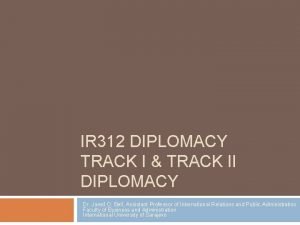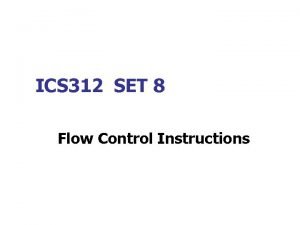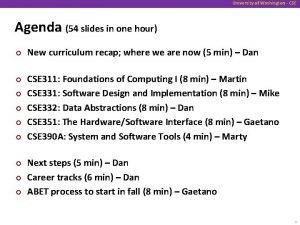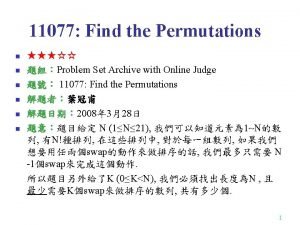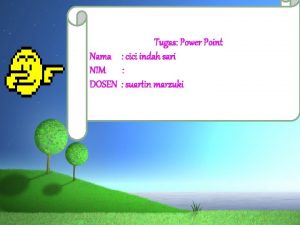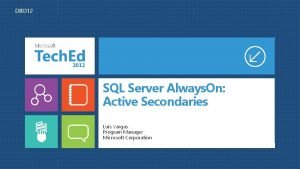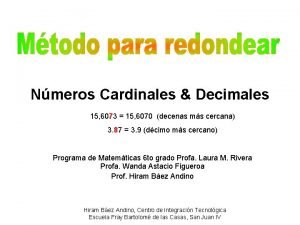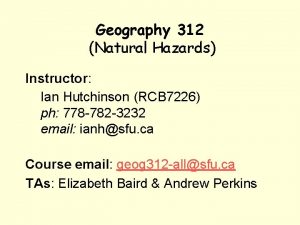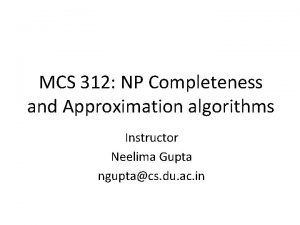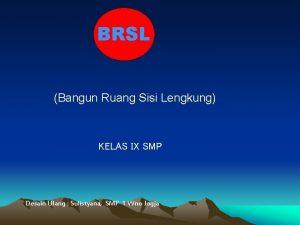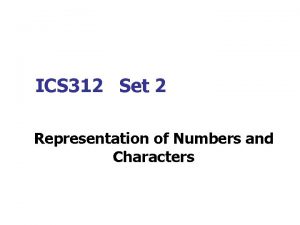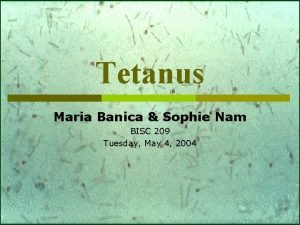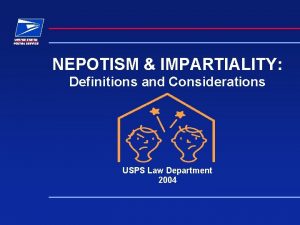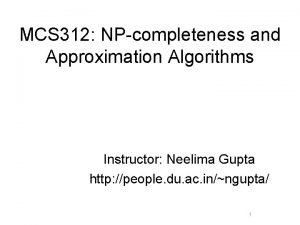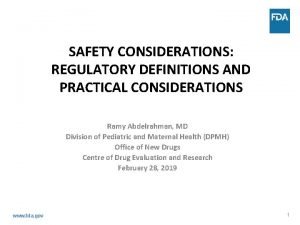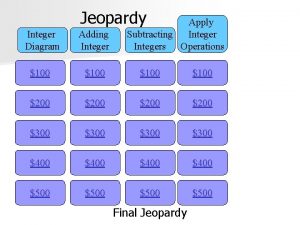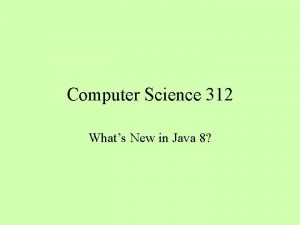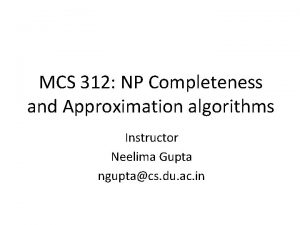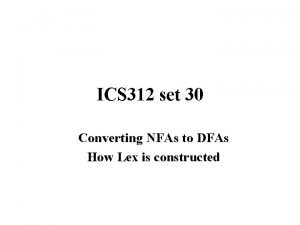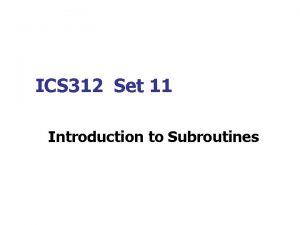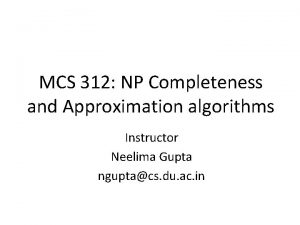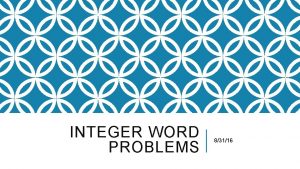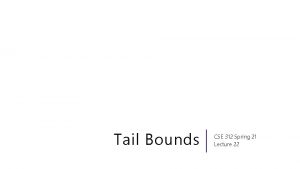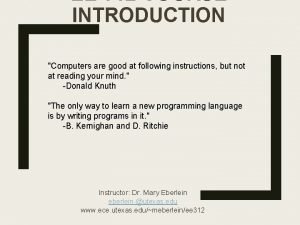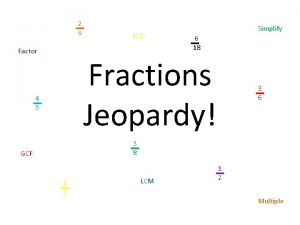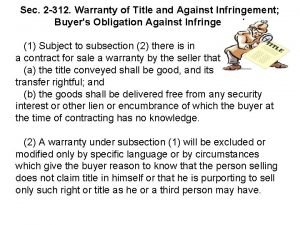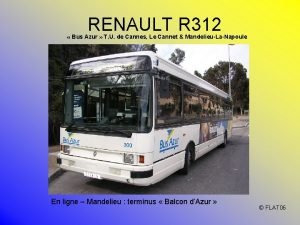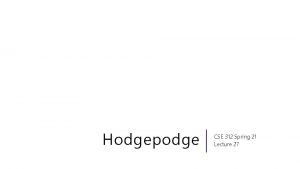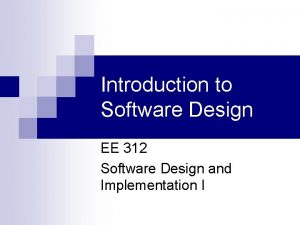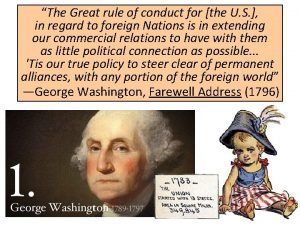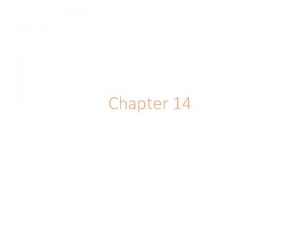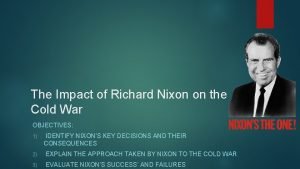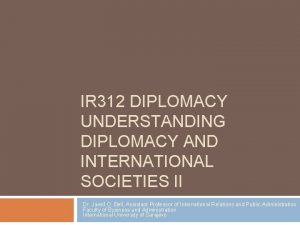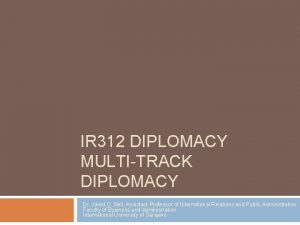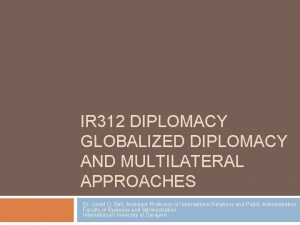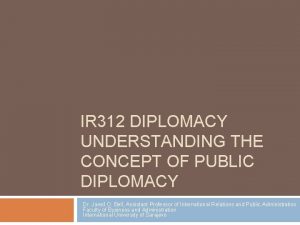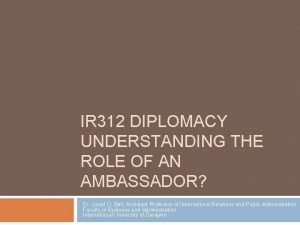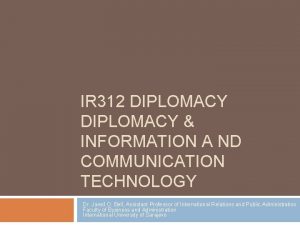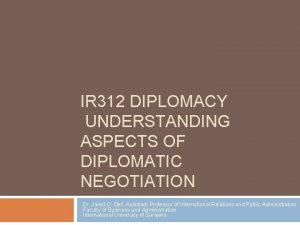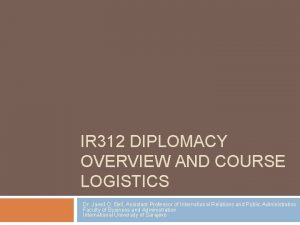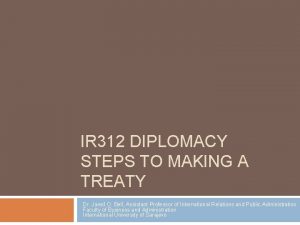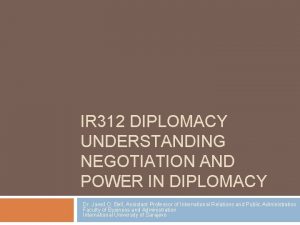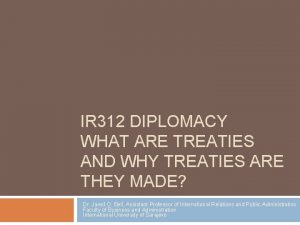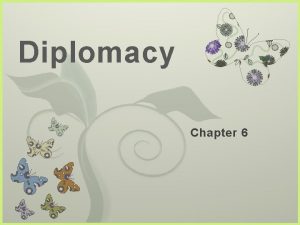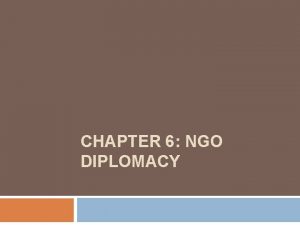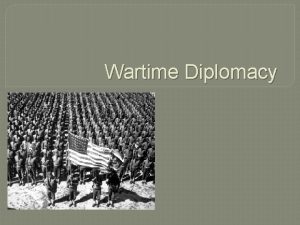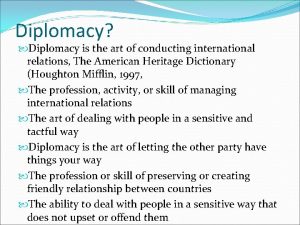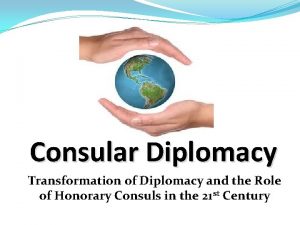IR 312 DIPLOMACY TRACK I TRACK II DIPLOMACY



































- Slides: 35

IR 312 DIPLOMACY TRACK I & TRACK II DIPLOMACY Dr. Jared O. Bell, Assistant Professor of International Relations and Public Administration Faculty of Business and Administration International University of Sarajevo

What are track of Diplomacy? What are tracks of diplomacy?

Tracks of Diplomacy is… Traditionally, the term "diplomacy" referred to interaction between nation-states. More recently, however, scholars have delineated several levels of diplomacy. Tracks 1 and 2 are the most frequently used terms.

Frequently Used Tracks Track One Track Two

History of these Terms In 1981, Joseph V. Montville, then a U. S. State Department employ ee, coined the phrases Track One and Track Two diplomacy in "Foreign Policy According to Freud", which appeared in Foreign Policy.

Track One Track 1 Diplomacy is official government diploma cy whereby communication and interaction is between governments What are some examples of Track 1 diplomacy?

How is Track one conducted? track-one diplomacy is conducted by official representatives of a state or state-like authority and involves interaction with other state or state-like authorities: heads of state, state department or ministry of foreign affairs officials, and other governmental departments and ministries.

How does track one take place? Official track, track-one diplomacy may take place bilaterally between two states, or multilaterally when several states interact together, and even regionally or globally through inter-governmental organizations.

Purposes and Intentions of track one Diplomacy track-one diplomacy may be used coercively and may involve sanctions, ultimatums, and psychological intimidation may be usedpersuasively and involve argumentation and/or compromise may be used as a means of adjusting states' relationship to and views of one another

Purposes and Intentions of track one Diplomacy (Cont. ) may be a tool for reaching mutual agreements---which may themselves reflect elements of persuasion or coercion. Track-one diplomacy may be used by a third-party state to help bring about an agreement between other states through mediation and negotiation

How is Track One Executed Informal consultations "Good offices" Special envoys Mediation Negotiations International condemnations Fact-finding missions

Informal Consultations States may informally consult and discuss a variety of issues from energy policy to human rights. Example: Germany and Britain’s discussions on Bosnia and reforms for EU membership.

Good Offices Influence. States and their diplomats can use their influences to benefit the causes of others states or groups within states. What are some examples? ?

Special Envoy As an appointed senior member of a country’s diplomatic corp, tasked with dealing with only a specific set of issues. Example: Richard Holbrooke was appointed special envoy to end war in Bosnia.

Mediation States may find them selves having to solve conflicts between two states or between groups within states. Example: US led mediation between Israel-Egypt (Camp David Accords 1978)

Negotiation States may negotiate on their behalf with other states on their on behalf or as a third party between two other states or a state and a nongovernmental actor. Example: Iranian Hostage Crisis

International Condemnation States may use condemn another state’s foreign policy or domestic actions. Example: condemnations from the International community for the coup in Turkey.

Fact Finding Missions States may send members of their diplomatic corp. to find out what’s going on in other countries. Example: In April UK Secretary of State visited Kenya to view UKaid projects and meet beneficiaries.

Understanding Track one and a half Mapendere (2000) defined Track One and a Half Diplomacy as public or private interaction between official representatives of conflicting governments or political entities such as popular armed movements, which is facilitated or mediated by a third party not representing a political organization or institution. The aim of such interaction is to influence attitudinal changes between the parties with the objective of changing the political power structures that caused the conflict (p. 16).

Strengths of Track One Diplomacy First, Track One Diplomacy has the ability to use political power to influence the direction of negotiations and outcomes (Sanders, 1991). This power might include using the threat of military force if a party decides to go against international treaties. Second, Track One Diplomacy has the capacity to access material and financial resources that give high leverage and flexibility in negotiations (Bercovitch and Houston, 2000). Third, Track One Diplomacy can employ in-depth knowledge about the parties’ interests because of the use of various intelligence sources (Stein and Lewis, 1996). Fourth, Track One mediators have the competence to use broad knowledge of their states’ foreign policies, and also the foreign policies of the conflicting parties.

Strengths of Track One Diplomacy (Cont. ) Third, Track One Diplomacy can employ indepth knowledge about the parties’ interests because of the use of various intelligence sources (Stein and Lewis, 1996). Fourth, Track One mediators have the competence to use broad knowledge of their states’ foreign policies, and also the foreign policies of the conflicting parties.

Weakness of Track One Diplomacy The first weakness of Track One Diplomacy is that its conflict resolution approaches are corrupted by power. State power can be a liability to durable peace, rather than a facilitative tool. Power can suppress underlying issues of weaker parties, thereby undermining the sustainability of a peace agreement (Diamond & Mac. Donald, 1996). Second, diplomatic missions, an asset to Track One Diplomacy, are normally closed down at the peak of conflicts between countries “thereby reducing communication when it is needed most” (Ziegler, 1984, p. 27). Third, officials cannot, of course, speak against their country and, as a result, may either be too rigid or delay negotiations through consultations with their leaders at home (Volkan, 1991; Sanders, 1991). Fourth, Track One Diplomacy is affected by electoral cycle.

Track 2 diplomacy refers to "non-governmental, informal and unofficial contacts and activities between private citizens or groups of individuals, sometimes called 'nonstate actors. Example: The NGO Search for a Common Ground that works to develop peace building Mechanisms.

How is Track II Diplomacy Conducted? At the international level, the term encompasses a number of different terms: "track two diplomacy, " citizen diplomacy, "multi-track diplomacy, " supplemental diplomacy, pre-negotiation, consultation, interactive conflict resolution, back-channel diplomacy, facilitated joint brainstorming , , coexistence work. While differing in emphasis, agenda, and theoretical approach, these initiatives share many common goals. They attempt to provide an environment that is low-key, nonjudgmental, non-coercive, and safe, and to create a process in which participants feel free to share perceptions, fears and needs, and to explore ideas for resolution, free of the constraints of government positions. The process is designed to encourage the development of mutual understanding of differing perceptions and needs, the creation of

How does track II Happen? Montville (Davidson & Montville, 1981) maintains that there are two basic processes in track two diplomacy: The first consists of facilitated workshops that bring members of conflicting groups together to develop personal relationships, understand the conflict from the perspective of others, and develop joint strategies for solving the conflict. The second process involves working to shift public opinion: "Here the task is a psychological one which consists of reducing the sense of victimhood of the parties and rehumanizing the image of the adversary

Facilitated Work Shops These are work shops that bring a variety of actors together from community leaders to residents to figure out how to move beyond a conflict.

Working to Shift Public Opinion This a process that might be done through using a variety of methods including television, news paper, trainings, community conferencing or dialoging to change perceptions of the public within a particular on conflict.

Purposes and Intentions of Track II Largely, it is there to assist official actors to manage and resolve conflicts by exploring possible solutions derived from the public view and without the requirements of formal negotiation or bargaining for advantage.

Strengths of Track II Diplomacy First, Track Two parties are not inhibited by political or constitutional power; therefore, they can express their own viewpoints on issues that directly affect their communities and families. Second, Track Two officials do not have the fear of losing constituencies because they are the constituency. Third, Track two empowers the socially, economically, and politically disenfranchised groups by giving them a platform from which they can air their views on how peace can be achieved in their own communities or nations.

Strengths of Track II Diplomacy (Cont. ) Fourth, Track Two is effective both at the previolent conflict and post violent conflict stages; therefore it is a very effective tool for violent conflict prevention and post-conflict peacebuilding. Fifth, Track Two involves grassroots and middle leadership who are in direct contact with the conflict. Sixth, Track Two is not affected by electoral cycles.

Weaknesses of Track II The first weakness is that Track Two participants have limited ability to influence foreign policy and political power structures because of their lack of political power. Second, Track Two interventions can take too long to yield results. Third, Track Two has limited ability to influence change at the war stage of a conflict. Fourth, Track Two participants rarely have resources necessary for sustained leverage during negotiations and for the implementation of agreements.

Weaknesses of Track II (Cont. ) Fifth, Track Two is not effective in authoritarian regimes where leaders do not take advice from lower level leaders. Sixth, Track Two actors due to their lack of political power, are in most cases not accountable to the public for poor decisions. Seventh, because of their multiplicity Track Two actors/organizations are notoriously known for their lack of coordination.

Comparative Advantages Track one actors are more likely to have resources and status. They may have powerful ‘carrots’ and ‘sticks’ in terms of their ability to intervene militarily, support peace processes/agreements with monitors and peacekeepers, and give or withhold legitimacy, aid, trade or loans, etc. They may also be constrained from acting effectively as they may be wary of conveying status and legitimacy on ‘rebels’, may be compromised by national interest or seen as too partial toward one of the combatants or have too great a stake in the outcome of the process.

Comparative Advantages (Cont. ) Track two parties are less threatening to armed groups, and find it easier to work flexibly, unofficially, and offthe-record, and have less to be concerned about in terms of conveying official/legal recognition. Lacking geopolitical interests and stakes in the conflict, they may be more impartial, forming relationships with a wider variety of actors in the conflict, and hearing things official actors do not. On the other hand, they lack the capacity to compel or coerce parties, can have a harder time ‘gaining entry’ to a conflict (especially with state actors), and cannot provide the same incentives and guarantees as a track one actor. they often lack resources and funding, especially for their more longer-term work that is ‘out of the spotlight’.

Track I and II Together Track two can assist the process of understanding for track one diplomacy. Track two can help build the willingness and ability conflicting parties to participate successfully. Track two can help Keep lines of communication open Track one maybe able to provide track two with resources and possibly influence to help track two.
 What is track 2 diplomacy
What is track 2 diplomacy Flow control instructions
Flow control instructions Cse 332 uw
Cse 332 uw 123 132 213 231 312 321
123 132 213 231 312 321 Bagian dalam sebuah pipa paralon yang berjari
Bagian dalam sebuah pipa paralon yang berjari Ssis 312
Ssis 312 5 decenas de millar + 9 centenas + 3 unidades + 4 milesimos
5 decenas de millar + 9 centenas + 3 unidades + 4 milesimos Natural hazards definition ap human geography
Natural hazards definition ap human geography Mcs 312
Mcs 312 Brsl
Brsl Ics 312
Ics 312 Oposthotonus
Oposthotonus El 312 usps
El 312 usps Mcs 312
Mcs 312 21 cfr part 312
21 cfr part 312 Jeopardy adding and subtracting integers
Jeopardy adding and subtracting integers Java 8 312
Java 8 312 Mcs 312
Mcs 312 Ics 312
Ics 312 Altivar 312 solar
Altivar 312 solar Ics 312
Ics 312 Mcs 312
Mcs 312 Katherine is very interested in cryogenics
Katherine is very interested in cryogenics Po box 30512 salt lake city
Po box 30512 salt lake city Cse 312
Cse 312 Ee 312
Ee 312 Simplify fractions
Simplify fractions 2-312
2-312 Bus 312
Bus 312 Cse 312
Cse 312 Ee 312
Ee 312 Favoring honorable diplomacy but still
Favoring honorable diplomacy but still Whats the big stick diplomacy
Whats the big stick diplomacy Becoming a world power lesson 3 new american diplomacy
Becoming a world power lesson 3 new american diplomacy Triangular diplomacy
Triangular diplomacy Define diplomacy
Define diplomacy
